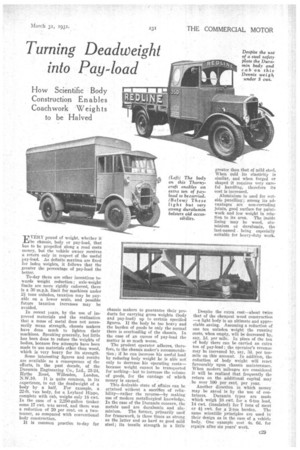Turning Deadweight into Pay-load
Page 51

If you've noticed an error in this article please click here to report it so we can fix it.
How Scientific Body Construction Enables Coachwork .Weights to be Halved
D VERY pound of weight, whether it
I U be chassis, body or pay-load, that has to be propelled along a road costs money, but the vehicle owner receives a return only in respect of the useful pay-load. As definite maxima are fixed for laden weights, it follows that the greater the percentage of pay-load the better.
To-day there are other incentives towards weight reduction ; axle-weight limits are more rigidly enforced, there is a 30 m.p.h. limit for machines under 24, tons unladen, taxation may be payable on a lower scale, and possible future taxation increases may be avoided.
In recent years, by the use of improved materials and the realization that a mass of metal does not necessarily mean strength, chassis makers have done much to lighten their machines. Speaking generally, but little has been done to reduce the weights of bodies, because few attempts have been made to use materials other than wood, which is very heavy for its strength.
Some interesting figures and results are available as a consequence of the efforts, in the past decade, of the Duramin Engineering Co., Ltd., 23-24, lEythe Road, Willesden, London, N.W.10. It is quite common, in its experience, to cut the deadweight of a body by a half. For example, a 22-ft van body, for a Leyland Hippo, complete with cab, weighs only 18 cwt. . In the case of a 2,250-gallon tanker some 17 cwt. was saved, and there was a reduction of 20 per cent, on a twotonner, as compared with conventional body construction.
It is common practice to-day for chassis makers to guarantee their products for carrying gross weights (body and pay-load) up to certain specified figures. If the body be too heavy and the burden of goods be only the normal there is overloadihg of the chassis. In the case of an excess of pay-load the matter is so much worse.
The prudent operator adheres, therefore, to the chassis maker's recommendation; if he can increase his useful load by reducing body weight he is able not only to decrease his operating costs— because weight cannot be transported for-nothing—bnt to increase the volume of goods, for the carriage of which money is earned.
This desirable state of affairs can be attained without a sacrifice of reliability—rather the reverse--by making use of modern metallurgical knowledge. In the case of the Duramin concern, the metals used are duralumin and aluminium. The former, primarily used for framework, is three times as strong as the latter and as hard as good mild steel; its tensile strength is a little greater than that of mild steel. When cold its elasticity is similar, and when forged or shaped it requires very careful handling, therefore its cost is increased.
Aluminium is used for outside panelling ; among its advantages are non-corroding joints, good surface for paintwork and low weight in rela tion to its area. The inside lining may be wood, aluminium or duralumin, the last-named . being especially suitable for heavy-duty work.
Despite the extra cost—about twice that of the cheapest wood construction —a light body is an ultimate and appreciable saving. Assuming a reduction of one ton unladen weight the running costs when empty, will be decreased by, say, id. per mile. In place of the ton of body there can be carried an extra ton of pay-load ; the operator's revenue may be increased by, say, 3d. per tonmile on this account. In addition, the reduction of body weight will react favourably upon chassis maintenance. When modern mileages are considered it will be realized that frequently the return on the additional capital may . be over 100 per cent, per year.
Another direction in which money may be saved is by the use of containers. Duramin types are made which weigh 10 cwt. for a 6-ton load, 14 cwt. (insulated) for 7 tons of meat or 4i cwt. for a 2-ton burden. The same scientific principles are used in their design as in the case. of a vehicle body. One example cost 4s, 6d. for repairs after six years' work.












































































































